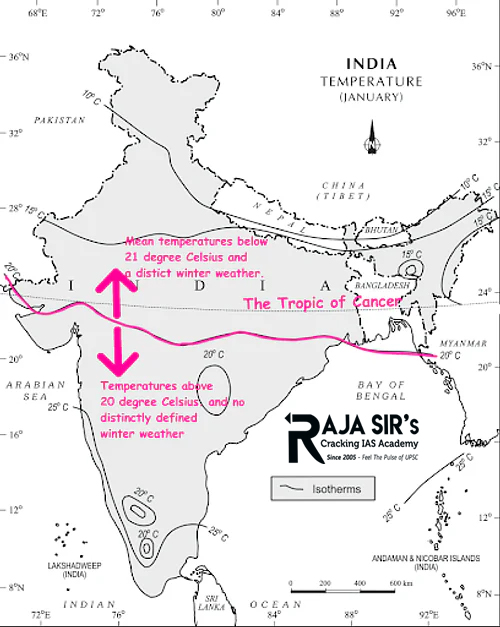- Home
- Prelims
- Mains
- Current Affairs
- Study Materials
- Test Series
Give a detailed account of weather conditions and characteristics of the cold waves in India. Examine its impact.
- A Cold Wave is defined as a sudden fall in temperature in the same region and date as compared to its normal temperatures for previous years. “Core Cold Wave Zone” is a zone which frequently witnesses cold waves from time to time.
- As per the Indian Meteorological Department (IMD), a cold wave in the plains occurs when the temperature drops below 10 degrees Celsius and the minimum temperature falls below 4.5 degrees Celsius. The criterion for hills is that they must be 0 degrees Celsius. In the plains, a severe cold wave occurs when the temperature falls below 6.4 degrees Celsius or falls below 2 degrees Celsius. It’s “a state of air temperature that becomes lethal to the human body when exposed,” according to the IMD. Every five days, the ‘normal’ temperature is computed by computing the mean temperature for all these days over the previous 30 years.
Factors Responsible for this Cold Wave
- Large Scale Fog:
- One of the major factors contributing to colder than normal temperatures over north India in January 2023 is thelarge-scale fog cover, according to India Meteorological Department (IMD).
- Fog has been lasting for longer durations, preventing sunlight from reaching the surface and affecting the radiation balance.There is no heating in the day time, and then there is the impact of the night.
- Foggy Nights:
- Foggy or cloudy nights are usually associated with warmer nights, but if the fog remains for two or three days, cooling begins even at night.
- Light winds and high moisture near the land surface have been contributing to the formation of a blanket of fogover large swathes of the Indo-Gangetic plains in the morning.
- Westerly Winds:
- Since there has not been any significant impact ofwestern disturbances over the region, cold northwesterly winds have also been contributing to low temperatures.
- Westerly andnorthwesterly winds of around 5 to 10 kmph in the afternoon have also been contributing to the dip in temperature
India’s ‘core cold wave zone’ covers Punjab, Himachal Pradesh, Uttarakhand, Delhi, Haryana, Rajasthan, Uttar Pradesh, Gujarat, Madhya Pradesh, Chhattisgarh, Bihar, Jharkhand, West Bengal, Odisha and Telangana.
Causes of Cold Wave in India
- Absence of Cloud Cover in the Region:Clouds trap some of the outgoing infrared radiation and radiate it back downward, warming the ground.
- Snowfall in the upper Himalayas that has blown cold winds towards the region.
- Subsidence of Cold Air over the Region:Subsidence is the downward movement of cold and dry air closer to the surface.
- La Nina:Prevailing La Nina conditions in the Pacific Ocean. La Nina is the abnormal cooler sea surface temperatures reported along the equatorial Pacific Ocean and it is known to favour cold waves.
- During La Nina years, the severity of cold conditions becomes intense. The frequency and area covered under the grip of a cold wave becomes larger.
- Western Disturbances: Western disturbances can cause cold waves in India. Western disturbances are weather systems that originate in the Mediterranean Sea and move eastward, bringing cold winds, precipitation and cloud cover to the northwest regions of India. These disturbances can lead to a drop in temperature and cause cold wave conditions. However, not all western disturbances bring cold wave conditions.
Impact of Cold Wave
- Impact Agriculture: Cold waves bring unexpected freeze and frost during the Rabi cropping season affecting crops, horticultural plantations/orchard, and other agricultural allied services.
- Impact on livestock: During a cold wave, the animals require a higher intake of nutrition. If the food is inadequate and there is exposure to low temperatures, animals may die of hypothermia or starvation.
- Impact on Health: The cold wave is extremely fatal to human health, and it could affect vulnerable people (infants, pregnant women, and elderly people) with chronic diseases.
- Impact on energy sector: The impact on the energy sector is well marked with a rise in the demand for fuels and electricity during cold wave conditions.
- Impact visibility: Fog formation associated with cold waves can affect visibility, which can cause more accidents, including fatalities.
- Impact on infrastructure: For instance, specific plumbing is required in colder regions. Similarly, antifreeze needs to be added to the car for it to function.
Additional Information










 Latest News
Latest News

 General Studies
General Studies